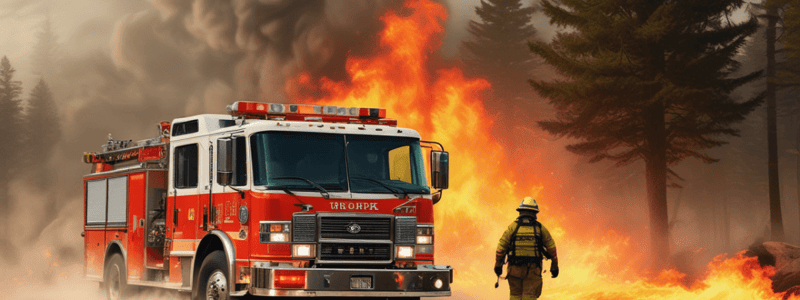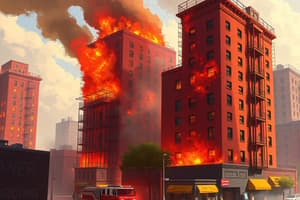Podcast
Questions and Answers
What is a critical consideration for Command during fire operations?
What is a critical consideration for Command during fire operations?
- Focusing solely on visual information gathering
- Sticking to the initial incident action plan
- Ignoring incomplete information during initial size-up
- Continually re-evaluating fireground factors based on new information (correct)
What is defined as critical unknown information during an incident?
What is defined as critical unknown information during an incident?
- Information gathered from visual observation
- Significant questions regarding incident structure, conditions, and/or occupancy (correct)
- Information from pre-fire planning and familiarity
- Information gathered from reconnaissance
What is the primary purpose of reconnaissance during an incident?
What is the primary purpose of reconnaissance during an incident?
- To gather information that is not visually available to Command (correct)
- To provide a 360° report to other responders
- To gather visual information from a distance
- To assign tasks to other responders
What type of information is gained from formal pre-fire planning and familiarity activities?
What type of information is gained from formal pre-fire planning and familiarity activities?
What is the benefit of using all methods of information gathering and communication?
What is the benefit of using all methods of information gathering and communication?
During an incident, how is fireground factor information typically gathered?
During an incident, how is fireground factor information typically gathered?
Why is it essential to continually revise the incident action plan?
Why is it essential to continually revise the incident action plan?
What is the relationship between fireground factors and incident situation?
What is the relationship between fireground factors and incident situation?
How does effective information management contribute to fire operations?
How does effective information management contribute to fire operations?
What is the primary purpose of Critical Fireground Factors?
What is the primary purpose of Critical Fireground Factors?
What is the definition of size-up?
What is the definition of size-up?
Why is it important to identify critical fireground factors?
Why is it important to identify critical fireground factors?
What is the consequence of not adequately performing size-up and considering critical fireground factors?
What is the consequence of not adequately performing size-up and considering critical fireground factors?
What is the characteristic of a non-thinking attack situation?
What is the characteristic of a non-thinking attack situation?
What is the role of Critical Fireground Factors in the fireground process?
What is the role of Critical Fireground Factors in the fireground process?
What should the Incident Commander do with non-critical factors during size-up?
What should the Incident Commander do with non-critical factors during size-up?
Why is it important to consider Critical Fireground Factors during an incident?
Why is it important to consider Critical Fireground Factors during an incident?
What is considered when evaluating the size of a building during a fire?
What is considered when evaluating the size of a building during a fire?
What is a key factor in determining the direction of travel of a fire?
What is a key factor in determining the direction of travel of a fire?
What is considered when evaluating the occupancy of a building?
What is considered when evaluating the occupancy of a building?
What is a key factor in determining the life hazard of a situation?
What is a key factor in determining the life hazard of a situation?
What is considered when evaluating the arrangement of a building during a fire?
What is considered when evaluating the arrangement of a building during a fire?
What is a key factor in determining the resources required to respond to a fire?
What is a key factor in determining the resources required to respond to a fire?
What is considered when evaluating the fire itself during a fire?
What is considered when evaluating the fire itself during a fire?
What is a key factor in determining the risk of fire spread to external exposures?
What is a key factor in determining the risk of fire spread to external exposures?
What is considered when evaluating the condition of occupants during a fire?
What is considered when evaluating the condition of occupants during a fire?
What is a key factor in determining the need for EMS during a fire?
What is a key factor in determining the need for EMS during a fire?
Flashcards are hidden until you start studying
Study Notes
Fireground Factors
- Fireground factors are a standard list that Incident Commanders must consider in evaluating an incident
- Critical Fireground Factors are determined through deliberate and focused size-up to determine how and to what extent tactical objectives will be met
- Size-up is an appraisal of the magnitude or dimensions of an event or incident
Importance of Size-up
- Size-up is critical in identifying what is truly important to the incident outcome
- Incident Commanders must set aside or disqualify non-critical factors
- It is unacceptable to begin operations before adequately performing size-up and considering critical fireground factors
Dynamic Fireground Process
- Fireground factors are dynamic and their relative importance changes throughout the incident
- Command must continually deal with changes and base decisions on timely and current fireground factor information
- Effective fire operations require action plan revisions that continually reconsider fireground factors
Critical Unknown Information
- In critical fire situations, Command may develop an incident action plan based on incomplete information
- Efforts must continue to improve information on which decisions are based
- Critical unknown information includes incident structure, conditions, and/or occupancy
Information Gathering and Communication
- Effective management of fireground factors requires Command to apply all methods of information gathering and communication
- Methods include visual, reconnaissance, and preplanning
- Visual information is gathered through observation and perception
- Reconnaissance involves sending someone to check-out and gather information
- Preplanning involves gathering intelligence from formal pre-fire planning, informal familiarization, and CAD through MDT
Fireground Factor Categories
Building
- Factors include size, roof type and condition, interior arrangement/access, construction type, age, condition, value, compartmentation/separation, and utility characteristics
Fire
- Factors include size, extent, location, stage, direction of travel, time of involvement, type and amount of material involved, product of combustion, and time projection on continuing fire effect on the building
Occupancy
- Factors include specific occupancy, type/group, value characteristics, fire load, status, occupancy associated characteristics/hazards, type of contents, and loss control profile
Life Hazard
- Factors include number of occupants, location and condition of occupants, incapacities, commitment required for search and rescue, fire control required for search and rescue, needs for EMS, and time estimate of fire effect on victims
Arrangement
- Factors include access, arrangement, and distance of external exposure, combustibility of exposures, access and nature of internal exposures, severity and urgency of exposures, value of exposures, and most dangerous direction
Resources
- Factors include personnel and equipment on scene, responding, and available in reserve, estimate of response time for additional resources, condition of personnel, capability and willingness of personnel, availability of hydrants, and supplemental water sources
Other
- Factors include time of day/night, day of week, season, special hazards by virtue of holidays and special events, weather, traffic conditions, and social conditions
Studying That Suits You
Use AI to generate personalized quizzes and flashcards to suit your learning preferences.




